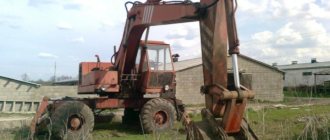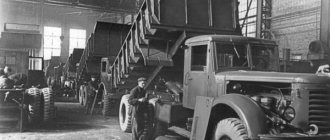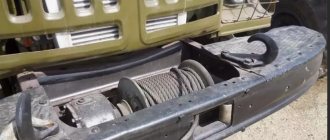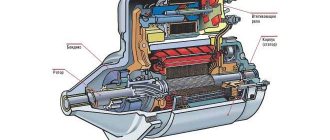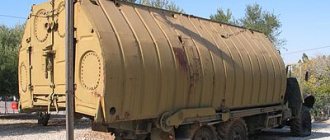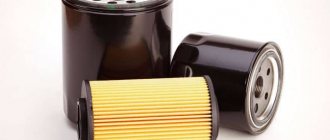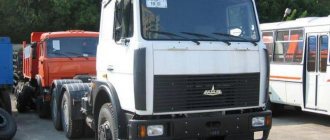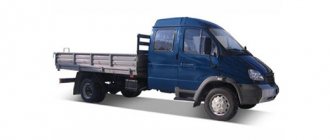The history of the creation of KrAZ-260
KrAZ-260 replaced the heavy all-terrain vehicle KrAZ-255B at the combat post of its older brother. August 8, 1967 is the start date for mass production. The release of the all-terrain vehicle continued until the end of 1994. The people called him "baptist", "baptist". More than 82,000 trucks rolled off the factory assembly line during this time.
The main customer of the Kremenchug plant was the military sector. In addition, the vehicle was operated in the national economy. The car transported various cargoes and people and was popular not only in the territory of the former USSR. Universal equipment was also purchased by foreign companies.
Specifications KrAZ-260
The new truck, for that time, used a powerful engine and applied technical innovations for its stable operation.
Engine KrAZ-260
In the engine compartment, the plant's engineers installed a turbocharged YaMZ-238L engine. Such a powerful power unit made it possible for the KrAZ-260 with a carrying capacity of 9500 kg to successfully cope with the assigned tasks.
Motor type piston with a longitudinal arrangement in front. The power of the 2-valve 8-cylinder power unit was 300 horsepower. The engine block was made of cast iron. The working volume of the power plant is within 14,860 cm³.
It must be emphasized that the truck was constantly operated in difficult and difficult conditions. In this regard, the design bureau of the plant applied a fundamentally new solution. Specialists have added 2 dry type air filters using two-stage dirt cleaning and automatic dust removal. Engineers have changed exhaust systems. They refused to install a silencer, using a pressure turbine.
The truck was operated not only in the central part of the country. He performed assigned tasks in the regions of the Far North. In this regard, for a quick start of the power unit at negative t0, an installation of an electric torch type was provided: the Thermostat device. The starting preheater ensured a stable engine start at sub-zero temperatures.
Truck transmission
A powerful power unit assumed the use of a new manual transmission 8 (gearbox). The engine was aggregated with a YaMZ-238B transmission in four steps using synchronizers in all forward gears without exception.
Amendments were made to the transfer case in two stages. Transfer case control of electropneumatic type. This made it possible to lock the center differential. It was enough to press the necessary switch installed on the instrument panel.
The design used a two-plate dry clutch: model 260. The specialists made adjustments and finalized the front axle of the car, borrowed from the previous model. The middle bridge of the truck was made passable.
cargo platform
Frame: longitudinal spars. Channel type. The connection was carried out using stamped cross members, which were fastened with bolts.
Dimensional and mass indicators
- Length - 9030 mm.
- Width - 2722 mm.
- Height - 3230 mm. (according to the cabin height without load)
- The height of the awning is 3115 mm. (without load)
- Platform loading height - 1560 mm.
- Load capacity - 9500 kg.
- Weight with winch - 12425 kg.
- Gross weight - 2200 kg.
- When using a trailer or semi-trailer - a load of 10 thousand kg.
- Entry angle - 580.
- Turning diameter - 27 m.
Brake system
The design of the 420 mm drum-type brakes provided for the use of internal pads on all wheels. A separate pneumatic combined drive assumed the passage from the lower section of the brake valve to the front and intermediate axle. And from the upper section of the brake valve to the rear axle.
The use of this system made it possible to control the trailer brakes in a single-wire or two-wire circuit. An air pressure of 8.0 kgf/cm2 was allowed in the brake system. The parking brake blocked the brake wheel mechanisms of the intermediate and rear axles. There was a process of compression of the springs of the pneumatic spring chambers.
An auxiliary brake system was provided. The design type is throttle, compression, mounted in the exhaust gas emission system. The auxiliary brake system was provided with an electric drive for engaging the trailer brakes.
additional characteristics
- A truck with a 6x6 wheel formula could effortlessly overcome a water barrier of 1.2 meters.
- The clearance is comfortable, as for a heavy car, 370 mm.
- The equipment was equipped with discless wheels. The design used removable side rings. Wheel rim 440-533. The plant installed stationary tires of the VND-201 model in the amount of 1300/530/533.
- Wheel track within 21600 mm.
- The center distance between the front and intermediate axles is 4600 mm.
- The indicators between the axles of the rear and intermediate axles were 1400 mm.
- Two fuel tanks for 330 liters (2x165) and an additional fuel tank for 50 liters of diesel fuel made it possible to overcome considerable distances without stopping.
- A car with full tanks could be on the road, covering a distance of 1 thousand km.
- At a speed of 60 km per hour, fuel consumption was 38.5 liters per 100 km. When driving at a speed of 50 km per hour, the consumption per 100 kilometers was reduced by 4.5 liters and amounted to 34 liters.
- The maximum speed of movement in the highest gear was limited by the speedometer reading of 80 kilometers.
Cars KrAZ-255B and KrAZ-255V technical description and operating instructions (TO)
(Zabolotsky G.K.) - 1980
This Technical Description and Operating Instructions repeat those issued by the Kremenchug Automobile, fifth edition, revised, Kharkov, Prapor, 1977.
The book was republished especially for military drivers of KrAZ-255B and KrAZ-255V vehicles.
The "Technical description" section contains the main technical data of cars, features of their device, principles of operation and methods for adjusting assembly units and assemblies. The Operation of Vehicles section contains recommendations for the correct operation of vehicles in various conditions and the elimination of simple malfunctions. The "Maintenance" section sets out the maintenance rules, the implementation of which ensures the constant serviceability and readiness of the car for operation. The appendices to this book contain the necessary reference materials.
Information about the design, operation and maintenance of the YaMZ-238 engine (with clutch and gearbox) is given in a separate Operating Instructions "YaMZ-236 and YaMZ-238 Engines", which is attached to each vehicle.
When using this book, it should be borne in mind that the running-in, maintenance standards and storage of vehicles must be carried out in accordance with the Manual on the Automobile Service of the Soviet Army and Navy.
WARNING
1. Persons who have passed tests on the material part, rules of operation and driving of KrAZ-255B and KrAZ-255V vehicles may be allowed to drive a car.
2. The movement of the car should be started after the engine has been preheated to a coolant temperature of 40 ... 50 ° С. During movement, the temperature of the coolant must be maintained within 75 ... 98 ° C. It is impossible to allow the engine to work under load at a coolant temperature below + 70 ° C, since in this case fuel combustion worsens, products of incomplete combustion condense on the walls of the liners, wear of liners and piston rings increases sharply, engine efficiency decreases.
3. The oil pressure on a warm engine should be
4… 7 kgf/cm2 at 2100 rpm and not less than 1 kgf/cm2 at the minimum idle speed of the engine shaft. After long-term operation, it is allowed to operate the engine at an oil pressure in the lubrication system of at least 3.5 kgf/cm2 at rated frequency and at least 0.5 kgf/cm2 at the minimum engine shaft speed.
4. The air pressure in the pneumatic system must be within
6 ... 7.3 kgf / cm2, but not lower than 7.65 kgf / cm2.
5. Tire pressure must correspond to specific road conditions according to the table. 10. Nominal air pressure in tires - 3.5 kgf / cm2. It is not recommended to reduce the air pressure in the tires if it has increased as a result of the heating of the tires while driving.
6. When the car is coasting, it is forbidden to set the transfer case control lever to the neutral position.
7. When towing the vehicle, the transfer case control lever must be in the neutral position, and the towing speed must not exceed 20 km/h.
8. When operating the car in the autumn-winter and spring periods, disconnect the oil coolers from the engine lubrication system using a valve located on the left side of the engine.
9. Operation of the car with a faulty (non-working) power steering booster is not allowed. For the possibility of short-term driving with a faulty hydraulic booster when going to the garage (service point), the speed should not exceed 20 km / h.
10. It is forbidden to turn on the front drive axle and block the center differential when the wheels are slipping, as well as when driving on paved roads and on dry dirt roads.
11. When operating a car, it is prohibited to use a common belt to drive the generator and compressor and use the generator as a tension roller.
12. It is forbidden to start the engine with the positive wire of the generator disconnected (broken) and disconnecting the batteries from the "mass" of the car with the engine running, as this will lead to increased voltage on the generator and failure of the generator rectifier unit.
13. Reversal of polarity when connecting the wire ends to the output terminals of the batteries leads to failure of the stator winding and the rectifier unit of the generator.
14. There is no reverse current relay in the vehicle electrical system. Therefore, after each engine stop, it is necessary to disconnect the batteries with a battery switch in order to prevent them from discharging through the excitation winding of the generator. It is allowed to turn on the batteries when the engine is not running only if it is necessary to use lighting and signaling.
15. When connecting a trailer (semi-trailer) alarm, it is recommended to turn off the rear turn signal lamps of the car with a switch installed at the end of the frame, for which you should press the top button until it clicks.
16. Push-button bimetallic fuses are installed in the lighting and starting heater circuits, which open the circuit in case of a short circuit in it. If the circuit is opened by the fuse, you must first find and eliminate the malfunction, and then turn on the fuse by briefly pressing the button until it clicks. It is strictly forbidden to press the fuse button with a faulty circuit.
17. In order to prevent the winch cable from pulling out of its fastening socket, it is necessary that at least four turns of the cable always remain on the winch drum before starting to pull up.
18. The operation of the winch with the release of the cable forward is only allowed using the block included in the accessory kit
car KrAZ-255B.
19. When the car is parked for a long time, it is recommended to close the wheel valves in order to avoid air leakage from the tires.
20. For the proper operation of the tire pressure control system at sub-zero ambient temperatures, it is recommended to close the wheel valves at the end of the working day (when the car is parked). open wheeled
speck follows after a run of 20 ... 25 km, since the frozen working edges of the stuffing boxes during this time will warm up and the tightness of the connection will be restored, and the absence of air pressure on the edges of the stuffing boxes will reduce the likelihood of edge breakage.
21. In the process of driving a car on sharp turns and when maneuvering, the return of the front wheels to the position corresponding to driving in a straight line is carried out by forcibly turning the steering wheel. Therefore, all maneuvers associated with turns must be performed at a speed that ensures traffic safety.
22. It is recommended to use the auxiliary brake for a short time (with the gear engaged) on steep and long descents, with forced braking on wet and slippery roads. It is forbidden to disengage the clutch and shift gears when the auxiliary brake is on to avoid failure of the clutch friction discs. If it is necessary to shift gears, release the auxiliary brake pedal.
23. The main condition for the trouble-free operation of the starting heater in winter is the complete draining of water from the engine cooling system and the heater system when the car is parked. To completely drain the water, you must:
install the car on a flat horizontal platform;
remove the plug of the expansion tank and the cover of the heater filler pipe;
open four drain cocks: on the engine water pump connection, on the boiler and heater pump unit, on the expansion tank; after draining the water for 10 ... 15 s two or three times (with an interval between switching on of 2 minutes), turn on the electric motor of the pump unit to remove condensate from the water pump of the heater, which will prevent the pump impeller from freezing.
24. In connection with the installation of wide-profile tires on a vehicle, the front drive axle, steering and other units require strict observance of the terms and scope of routine maintenance work. Failure to comply with this requirement usually results in gaps in hinged joints, loosening of fasteners and violation of adjustments. When operating a car with these deviations, especially in the speed range of 35 ... 45 km / h, vibrations of the front wheels (self-oscillations) may occur, which lead to intensive tire wear, increased driver fatigue and a threat to traffic safety. To eliminate these phenomena, it is recommended:
check and, if necessary, tighten the nuts for fastening the ladders and brackets of the front springs, the steering mechanism, the ball pins of the steering rods, the steering knuckle levers and the upper cover of the front axle kingpin bearing (the tightening torques of the threaded connections are indicated in Appendix 3);
check the installation of wheels on the hubs; with correct (without distortion) wheel installation, the difference between the ends of the hub and the adjusting ring of the wheel rim should not exceed 4 mm for diametrically located spokes;
check and, if necessary, adjust the toe-in of the front wheels within 0 ... 2 mm; wheel alignment more
2 mm is one of the main reasons causing fluctuations;
eliminate gaps in the steering joints (longitudinal and transverse steering rods and hydraulic booster);
eliminate the play in the bearings of the pivots of the steering knuckles of the front axle (the procedure for adjusting the bearings is described in the subsection "Drive axles");
if necessary, swap the wheels of the front axle with the wheels of one of the rear axles.
PRECAUTIONS AND FIRE SAFETY RULES FOR KrAZ-255B and KrAZ-255V VEHICLES
WHEN OPERATING VEHICLES KrAZ-255B and KrAZ-255V
1. The shift lever must be in neutral before starting the engine.
2. It is forbidden to start the heater in the presence of fuel and oil on the engine sump in order to avoid a fire, as well as to warm up the engine with a heater in enclosed spaces with poor ventilation in order to avoid exhaust gas poisoning. During the operation of the heater, the driver must not leave the vehicle. In the event of smoke and flames appearing on the exhaust (in the steady state of operation), you should immediately turn off the heater, disconnect the batteries from the ground, and only after that proceed with troubleshooting.
3. It is forbidden to operate a car whose tires have:
non-repaired local damages (breakdowns, through and non-through cuts), stones, nails, glass, etc. stuck in the tread and sidewalls of tires;
limit wear of the tread pattern when its residual depth in the center of the tread is less than 0.5 mm.
4. When the engine is warm, the cap of the expansion tank should be opened carefully to avoid burning hands with steam. To do this, put a rag on the cork, and turn your face to the side.
5. Take special care when handling ethylene-glycol coolants (antifreeze) to avoid poisoning them if they enter the body.
6. When the winch is working:
avoid jerking while pulling the load, as a sharp increase in load can cause a cable break;
not to be near a tensioned cable or between cables (when using a block);
do not allow the thimble to rest against the block of output rollers when winding the cable on the drum, as this can cause the cable to break and break the winch;
to prevent the formation of loops when issuing the cable or when winding it on the drum.
7. To ensure the safety of work when inflating tires in garage conditions, place the assembled wheel in a special grate, and outside the garage during this operation, direct the lock part away from people nearby.
8. When performing fastening work, you should use the tool in accordance with its purpose. It is unacceptable to build up (lengthen) the keys, install gaskets between the gap of the key and the edges of the nuts or bolts, hit the key with a hammer when unscrewing or wrapping. The wrench size must match the size of the nuts or bolt heads.
9. When checking the voltage at the output terminals of the batteries, use a load plug and a voltmeter. It is forbidden to check the voltage with a short circuit "to a spark".
10. During long descents or when coasting, it is forbidden to stop the engine. In these cases, the operation of the hydraulic booster pump and compressor stops, which leads to a sharp increase in the effort on the steering wheel and the consumption of compressed air in the brake cylinders.
11. When working with a spare wheel holder, in order to avoid accidents, it is prohibited:
be against the holder when lowering or raising the spare wheel;
lower the spare wheel with the ratchet pawl disengaged;
use homemade extension cords to the ratchet wrench, i.e. use levers, pipes, etc.
content .. 1 2 3 ..
Cabin KrAZ-260: overview of the workplace
There are three seats in the cab of the car, one of which is intended for the driver. The driver's seat is equipped with a sprung seat and is adjustable: for stiffness, length, height and tilt.
The double seat was intended for passengers. The cab is equipped with a heating system and windshield blowing with warm air.
To remove dirt and water from the windshield, the car was equipped with an electric windshield wiper and washer. Two rear-view mirrors are installed on the right and left side of the cab from the outside. The cabin had a ventilation system. A headlight/finder is mounted on the roof of the car. The package included a radio.
KrAZ-260 modifications
The plant produced a number of modifications:
- Truck tractor KrAZ-260 "B".
- KrAZ-260 "G" with an extended chassis.
- KrAZ-260 "A" without additional fuel tank.
- KrAZ-260 "D".
- Two variants of timber carriers: KrAZ-260 "L" and KrAZ-6437.
Truck tractor KrAZ-260 "V" In the product line of the plant, the truck tractor KrAZ-260 "V" occupied a special place, being in demand among customers. The car with a shortened frame was equipped with a fifth wheel coupling. Could easily tow semi-trailers with a total weight of up to 27.5 tons when traveling on paved roads. On dirt roads, it was allowed to tow a semi-trailer weighing up to 2300 kg.
This tractor was actively used in many sectors of the economy, was operated in the construction industry, agriculture. But the biggest customer was of course the military industry. Anti-aircraft missile systems and radar stations were installed on tractors.
KrAZ-260 "G" with an extended chassis. Based on this model, pontoon cars were produced. The extended chassis was perfect for installing desalination stations and drilling rigs on a car. The car was used as a tanker. This is an incomplete list of the use of KrAZ-260 "G".
And further. The plant also produced a prototype timber carrier KrAZ-260 "L", which was not put into mass production. It was replaced by KrAZ-6437.
Weight, load capacity
The curb weight of the car is 9.5 tons. Gross weight - 21.5. Thus, on board the machine is able to take up to 11 tons of cargo. At the same time, a towing device is provided in KrAZ.
On paved roads, the truck is capable of towing a trailer with a gross weight of up to 30 tons. For other types of roads and rough terrain - up to 10 tons.
Reviews of KrAZ-260 owners: advantages and disadvantages
Drivers of this truck have mixed opinions. But it must be remembered that this heavyweight was popular in the post-Soviet space and abroad.
Advantages Almost all owners note the power of the truck and the possibility of its operation in difficult climatic conditions. Thanks to the designers for the presence of a hydraulic system, which greatly facilitated the control of the vehicle. Many praise the cabin heating system.
Experienced drivers say that there were no problems with spare parts in the USSR. Unfortunately, today you can officially get the necessary parts by paying Ukrainian manufacturers only in foreign currency. Although there are a number of offers on the Internet for the sale of obsolete equipment in the Russian Federation.
Disadvantages Drivers often complain about the unreliable electro-pneumatic drive control of the transfer case. Often there are problems with non-replaceable drive axle gearboxes. There are also complaints about the unreliability of the braking system of the car.
Coastal link of the PPS-84 pontoon-bridge fleet based on the KrAZ-260 G vehicle.
Timber truck with a manipulator based on KrAZ 260 L.
Transmission
A four-speed YaMZ-238B gearbox with a demultiplier was used as a gearbox. In fact, the number of steps was more - eight forward and two back. Synchronizers were at all speeds except reverse.
Considering the KrAZ-260 device, it is worth noting the presence of a transfer case. It was a two-stage with a locking center differential. The torque between the bogie and the front axle was distributed in a ratio of 2:1. The highest gear had a number of 1.013, the lowest - 1.31. The transfer case received an electro-pneumatic drive. Power take-off was carried out from the engine. In the parking lot, the box could take up to 40 percent of the torque. In motion - half as much.
The main gear on the drive axle (there were three of them) was double, with spur and bevel gears. Differential locks were present on the middle and rear axles. The drive of inclusion of blockings – electropneumatic. The middle axle was of a through type, and the front axle was with disk joints of equal angular velocities. Off-road, this truck showed excellent cross-country ability. How the KrAZ-260 behaves on rough terrain, the reader can see in the video below.
Used KrAZ-260 price
The cost of a mass-produced car is affected by the year of manufacture of the car. Its technical condition and mileage. In addition, the seasonality of sales, currency fluctuations and the region from which the offer came from have an impact.
At the moment, the legendary truck can be purchased for 700 - 900 thousand Russian rubles. After the collapse of the USSR, there was a period when there was an acute shortage of spare parts. Today this issue is removed from the agenda. There are many offers on the Internet. In addition, specialized stores offer truck parts at reasonable prices.
